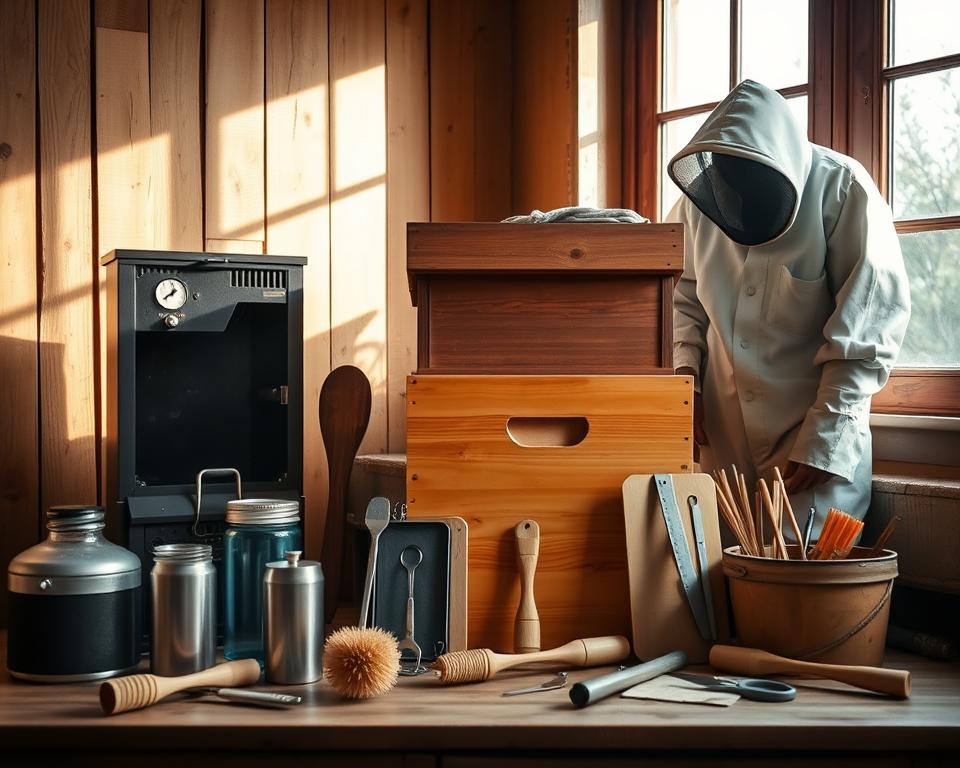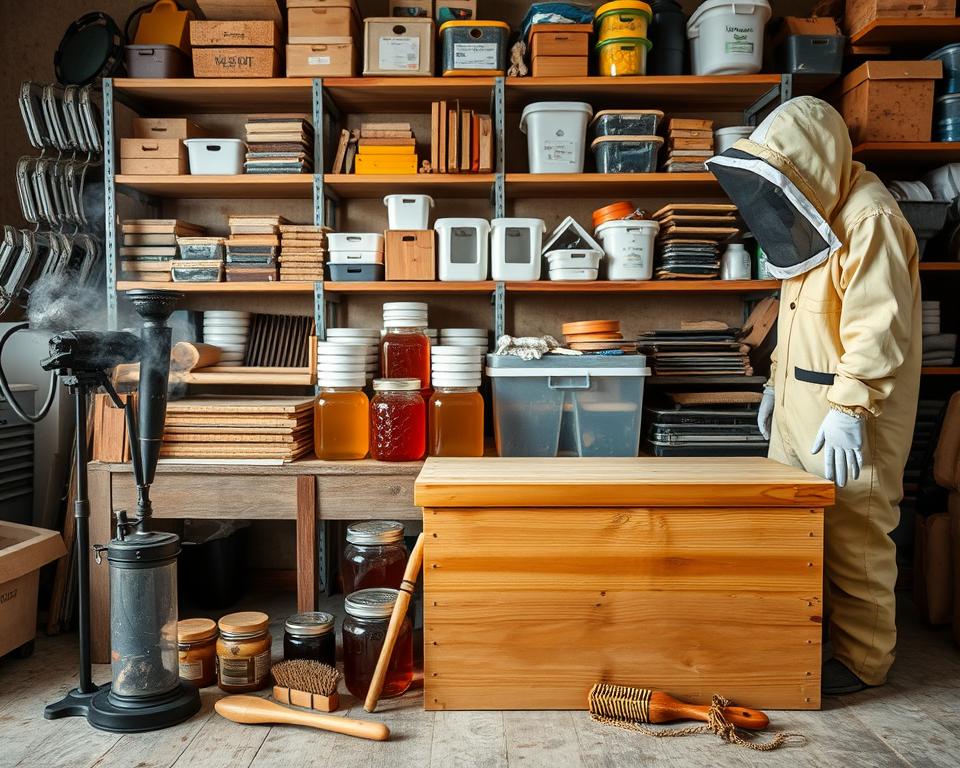Did you know a single honeybee colony can pollinate over 100,000 flowers in a day? Beekeeping is a rewarding hobby and a key part of our ecosystem. Setting up your first beehive might seem hard, but with the right help, you’ll be making honey soon.
I’ll show you the simple steps to start a thriving beehive. With a Beehive Starter Kit, you’ll have all you need. Beekeeping takes patience, but it’s great for the environment and local wildlife.
Key Takeaways
- Understand the basic components of a beehive
- Learn how to assemble your beehive with ease
- Discover the best practices for beginner beekeeping
- Find out how to source your bees and introduce them to the hive
- Gain insights into maintaining a healthy beehive
Understanding the Basics of Beekeeping
Before you start setting up a beehive, it’s important to know the basics of beekeeping. This hobby is rewarding, giving you honey and helping plants grow. It’s a great way to connect with nature.
What is Beekeeping?
Beekeeping, or apiculture, means taking care of bee colonies in a special place. You need to understand how bees behave and what they need. As a beekeeper, you’ll make sure your bees have a safe home and stay healthy.
Importance of Bees to the Ecosystem
Bees are key to pollinating plants, which helps many plants reproduce. Without them, our food supply would be at risk. Dr. Marla Spivak, a famous bee expert, said, “Bees are like canaries, showing us the health of our environment.”
“Bees are a keystone species; they are vital for the ecosystem’s health, and losing them could have big effects.”
Overview of Beehive Components
A beehive has important parts like the hive stand, hive body, frames, foundation, and supers. Knowing about these parts is key to good beekeeping.
| Component | Description |
|---|---|
| Hive Stand | Elevates the hive off the ground to protect it from pests and moisture. |
| Hive Body | The main chamber where the bees live and store honey. |
| Frames | Hold the foundation where bees build comb. |
| Foundation | A guide for bees to build straight comb. |
| Supers | Additional boxes for honey storage. |
To begin, you’ll need essential beekeeping supplies like protective clothes, a smoker, and hive tools. Good beehive equipment makes caring for your bees easier.
Choosing the Right Location for Your Beehive
Before setting up your beehive, think carefully about the location. The right spot is key for a healthy bee colony. It can greatly affect your beekeeping success.
Sunlight and Wind Protection
It’s important to find a spot that balances sunlight and wind protection. Bees need sunlight to navigate and keep the hive warm. They should get morning sunlight to start their day well.
But, the hive also needs protection from harsh winds. Winds can stress the bees and make it hard for them to keep the hive warm. Use trees or fences as natural or artificial windbreaks to protect your beehive.
Accessibility for Management
Accessibility is another key factor. You need to be able to check and manage the hive easily. Make sure the area around the beehive is clear of debris and plants.
Also, think about the height of the beehive stand. You want it to be easy to inspect without straining your back. A well-placed beehive makes Hive Assembly Tips and DIY Beehive Setup easier.
Proximity to Food Sources
Bees need a steady supply of nectar and pollen to do well. So, place your beehive near a good food source. This could be a garden, park, or natural area with lots of flowers.
The closer your beehive is to these food sources, the better. Your bees will spend less energy flying back and forth. This leads to a healthier and more productive colony. When setting up your beehive, make sure it’s close to floral resources.
By thinking about these factors, you can create a great environment for your bees. This ensures a successful and enjoyable beekeeping experience. Remember, the details of the location and setup are key to a thriving beehive.
Selecting the Best Beehive Type for Beginners
Choosing the right beehive is key for beginners in beekeeping. The type of beehive you pick can greatly affect your beekeeping journey. It impacts honey production, bee health, and how easy it is to manage your bees.
Langstroth Beehives
Langstroth beehives are a top pick for beginners. They have a vertical design that makes it easy to add more boxes and check on the bees. Langstroth beehives are versatile and easy to manage. But, they cost more upfront and can be heavy when full of honey.
Top-Bar Beehives
Top-Bar beehives offer a natural way to keep bees. They are cheaper to start and easier on the body. Top-Bar beehives encourage natural bee behavior. Yet, they might not produce as much honey, and checking on the bees can be harder.
Warre Beehives
Warre beehives are like a hollow log, giving bees a natural home. They are low maintenance and good for healthy bees. Warre beehives are perfect for those who like a hands-off approach. But, they might not be as good for honey, and adding or removing boxes can be tricky.
When picking a beehive, think about your goals, space, and how much work you want to do. Each beehive has its own special features. Knowing these can help you choose the best one for you as a beginner beekeeper.
Gathering Essential Beekeeping Equipment
Starting your beekeeping journey means getting the right gear. You need specific tools to manage your bees well and harvest honey safely. This ensures a good experience for you and your bees.
Protective Clothing and Gear
Protective clothing is key for beekeepers. You’ll need a beekeeping suit, veil, and gloves. The beekeeping suit keeps your body safe from stings. The veil covers your face and neck. Gloves protect your hands.

Tools and Accessories
Some tools are vital for beekeeping. You’ll need a smoker, hive tool, and frame grip. The smoker calms bees with smoke, making hive checks easier. The hive tool opens the hive and removes wax or propolis. A frame grip helps handle frames during inspections.
- A smoker to calm the bees
- A hive tool for opening the hive and scraping off wax
- A frame grip for handling frames
- Frames and foundation for the bees to build their comb
Hive Components Overview
The hive’s components are vital for your bees’ home. You’ll need a hive stand, bottom board, supers, and frames. The hive stand makes inspections easier. The bottom board is the hive’s base. Supers hold honey, and frames are for comb building.
For more on setting up a beehive, check out This Old House for a detailed guide.
Preparing Your Beehive Foundation
Before bees move in, you must prepare the beehive foundation well. This step is key for the colony’s health and success.
Constructing or Buying a Beehive
First, decide if you’ll build or buy a beehive. Building your own beehive saves money and lets you customize it. But, it needs carpentry skills and knowledge of hive design. Buying a beehive is easy and ensures it’s built right, but it costs more.
If you’re building, use untreated wood and a reliable design. For beginners, buying a pre-made hive or kit is a smart start.
Installing the Frames and Foundation
After preparing the beehive, install the frames and foundation. Frames give the bees a place to build their comb. Make sure they fit well in the hive.
The foundation, made of beeswax or plastic, guides the bees. It must be attached to the frames well to avoid sagging or falling.
Ensuring Proper Ventilation
Good ventilation is vital for a healthy hive. It helps control temperature and humidity, preventing disease and pests.
To ensure good air flow, check the hive’s spacing and the stand’s airflow. Some beekeepers use screened bottom boards for better ventilation.
Acquiring Bees for Your Beehive
Now that your beehive is ready, it’s time to bring home the bees. Getting bees is an exciting part of beekeeping. There are several options to choose from.
Options for Purchasing Bees
You can buy bees in different ways, like packages, nucs, or established colonies. Packages are great for beginners. They come with a queen and some worker bees. Nucs are smaller colonies with a queen and a well-set social structure.
Think about the cost, the bees’ health, and the season when choosing. It’s key to buy from a trusted supplier for healthy bees.
Installing Packages vs. Nucs
Packages are cheaper but need more work to start. Nucs are pricier but give a colony head start. Your choice depends on your experience, budget, and time to set up your colony.
| Feature | Packages | Nucs |
|---|---|---|
| Cost | Generally less expensive | More costly |
| Establishment Effort | Requires more effort | Easier to establish |
| Colony Structure | New colony | Established social structure |
Considerations for Bee Health
It’s vital to ensure your bees are healthy, whether you pick a package or nuc. Look for suppliers with disease-free bees. Inspect the bees before buying and ask about the queen and their health history.

Choosing healthy bees is key to a successful beehive. The health of your bees reflects your beekeeping skills.
Installing Your Bees in the Beehive
Getting bees into their new home is a big step in beekeeping. It needs careful planning and action to keep your bees healthy and alive.
Timing for Installation
The right time to put bees in their hive is important. Try to do it in the late morning or early afternoon. This is when most bees are out foraging, making the move less stressful for them.
Also, pick a calm, sunny day for the installation. Stay away from extreme weather like heavy rain or too much heat.
Techniques for Transferring Bees
When moving bees from their package or nuc to the hive, be gentle. First, take out the frames to make room. Then, shake or brush the bees into the hive, making sure the queen is safe.
Using a bee brush helps avoid hurting the bees. Smoke them lightly to calm them before you start moving them.
Minimizing Stress for the Bees
It’s important to reduce stress when putting bees in their new home. Make sure the hive is set up and all tools are ready before you begin.
Try to make the installation as smooth and fast as you can. Watch the bees after you’ve installed them to see how they’re adjusting to their new home.
By following these tips, you’ll be on the right path to successfully installing your bees. This will help your beehive thrive.
Conducting Regular Inspections of Your Beehive
Regularly checking your beehive is key to beekeeping success. It lets you keep an eye on your bees’ health and spot problems early. Knowing how to inspect your beehive well is very important.
When and How to Inspect
The best time to check your beehive is on warm, sunny days. This is when your bees are most active. Avoid cold or rainy days, as they can stress your bees. You’ll need Essential Beehive Tools like a smoker, hive tool, and protective clothes for the inspection.
Start by removing the outer and inner covers. Use your smoker to calm the bees. Then, take out the frames one by one. Look for disease, pests, or other issues. Check the queen and the brood’s condition too.
Identifying Common Issues
Look for pests, diseases, and nutritional problems during inspections. Check for queen failure signs like no eggs or a supersedure queen cell. Spotting these issues early can save your colony.
Some common problems include:
- Unusual odors or discoloration on the frames or inside the hive
- Bees that are aggressive or lethargic
- Visible pests or signs of disease on the bees or brood
- A lack of brood or eggs
Signs of a Healthy Colony
A healthy colony has a strong, active population. It has a visible and healthy queen and lots of brood and honey. The bees should be busy, and the hive should be clean.
“A beekeeper’s best friend is a notebook and pencil, for recording observations and insights during each inspection.” –
Having a Beehive Equipment List and the right Essential Beehive Tools makes inspections easier. Regular checks help you manage your beehive well and enjoy a good honey harvest.
Harvesting Honey from Your Beehive
After months of caring for your bees, it’s time to harvest honey. This process is rewarding but needs careful planning. It ensures you get high-quality honey.
Best Time to Harvest
The best time to harvest honey depends on several factors. These include the nectar flow, weather, and the bee colony’s strength. Honey is usually harvested in late summer or early fall.
It’s important to check the hive often to find the best harvest time. Harvest when at least 80% of the honeycomb cells are capped. This means the honey is ripe and ready.
Tools for Honey Extraction
To extract honey, you’ll need special tools. These include a honey extractor and uncapping knives or scratchers. The extractor gets honey from the comb without harming it. The uncapping tools remove the wax cappings from the cells.
- Honey extractor (manual or electric)
- Uncapping knives or scratchers
- Honey frames or baskets
- Strainers or filters
Tips for Storing Honey Properly
After extracting honey, it’s key to store it right. Honey is a supersaturated sugar solution. It’s sensitive to temperature, light, and moisture.
“Honey, if stored properly, can last indefinitely. But it’s best consumed within a year for the best flavor and quality.”
To store honey, use clean, dry containers with tight lids. Keep them in a cool, dark place. Avoid storing honey near heat or in sunlight to prevent degradation or crystallization.
Maintaining Your Beehive Year-Round
Keeping a beehive healthy all year is a big job. It involves watching for seasonal changes, fighting pests, and getting ready for winter. Knowing these tasks is key to your bees’ health and success.
Seasonal Management Practices
Every season brings its own challenges for beekeepers. In spring, check your hive for disease and make sure the queen is doing well. Summer is for managing the hive’s population and harvesting honey. Fall is for getting the hive ready for winter by stocking up on food. Using the right Beekeeping Supplies makes these tasks easier.
For beginner beekeepers, these tasks might seem hard at first. But with time, they become second nature. Keeping the hive clean and checking it regularly are key to a healthy colony.
Pest and Disease Control
Pests and diseases can harm your hive. Problems like varroa mites, American foulbrood, and nosema are common. Catching these early is key. Use a mix of methods to manage pests, like checking for mites and treating the hive when needed.
- Regularly inspect for signs of disease and pests.
- Use appropriate treatments when issues are identified.
- Maintain a clean and well-ventilated hive to prevent disease.
Winter Preparations for Your Bees
Winter prep is vital for your bees’ survival. Make sure they have enough food, like honey or sugar syrup, and keep the hive warm. Also, reduce the hive entrance to keep cold air and moisture out.
For new beekeepers, investing in quality Beekeeping Supplies for winter is important. It helps your bees stay healthy and strong through the winter, ready for spring.
Joining Local Beekeeping Clubs and Resources
Starting your beekeeping journey with a Beehive Starter Kit is exciting. Connecting with local beekeeping groups is very helpful. These clubs offer a chance to meet experienced beekeepers, learn new things, and keep up with local rules.
Community Support Benefits
Being in a beekeeping community has many perks. You get mentorship, hands-on training, and access to equipment. Clubs also host workshops and events. These are great for learning new skills and staying excited about beekeeping, even for beginners.
Local Courses and Online Resources
For more knowledge, look for local or online courses for beginners. These can teach you about beekeeping, managing pests, and making honey. They help you become more confident in your beekeeping skills.
Using these resources and joining local clubs can make your beekeeping journey rewarding and fun.
